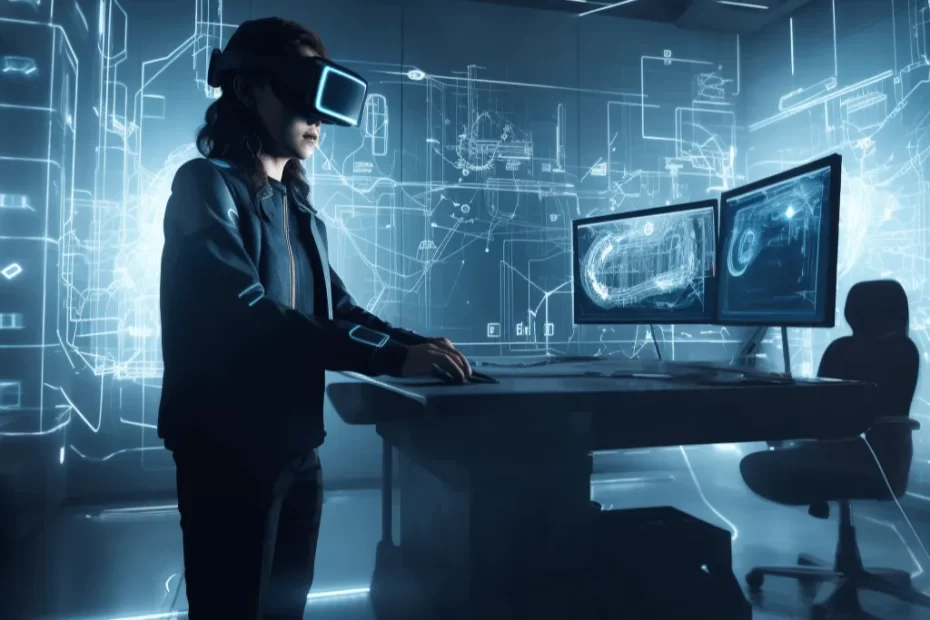Virtual reality (VR) design is a cutting-edge field that merges technology, creativity, and user experience to create immersive environments that can transport users to entirely new worlds. This article delves into the essentials of VR design, exploring the tools and best practices that can help designers create effective and engaging virtual experiences. Whether you’re a seasoned designer or just beginning to explore the world of VR, this comprehensive guide provides valuable insights that can enhance your understanding and capabilities in this rapidly evolving field.
Why This Article is Worth Reading
This article is a must-read for anyone interested in the future of digital experiences. As VR technology continues to develop, understanding how to design for this new medium is crucial. The information provided here will not only help you grasp the fundamentals of VirtualReality design but also equip you with practical tools and best practices that can elevate your projects. Whether you’re involved in product design, game design, or interior design, the insights shared here can be applied to a wide range of industries.
What is Virtual Reality Design?
Virtual reality design is the process of creating immersive digital environments that users can interact with using VR technology. Unlike traditional 2D or even 3D design, VirtualReality design requires a deep understanding of how users will physically and psychologically interact with the virtual world. VR designers need to create spaces that feel real, ensuring that the transition from the physical world to the virtual environment is seamless and intuitive.
The field of virtual reality design is still relatively new but is rapidly evolving as more industries recognize its potential. From gaming and education to healthcare and product design, VR is becoming an integral part of how we experience and interact with digital content. Understanding the principles of VR design is essential for anyone looking to create engaging and effective virtual experiences.
How Does VR Design Differ from AR and MR Design?
While VR design focuses on creating entirely virtual environments, augmented reality (AR) and mixed reality (MR) design blend the virtual and physical worlds. AR overlays digital content onto the real world, enhancing the user’s perception of their environment. MR, on the other hand, allows virtual objects to interact with the real world in real-time, creating a more integrated experience.
Designing for VR, AR, and MR each presents unique challenges. In VR, designers must consider the user’s complete immersion in a virtual world, while AR and MR require careful consideration of how digital content interacts with the physical world. The tools, techniques, and user experience considerations can vary significantly across these platforms, making it essential for designers to understand the nuances of each.
Why Ergonomics is Crucial in Design for VR
Ergonomics plays a critical role in Virtual Reality design, as it directly impacts the user’s comfort and experience. When users wear a VR headset for extended periods, poor ergonomic design can lead to discomfort, strain, and even motion sickness. Ensuring that the virtual environment is designed with the user’s physical comfort in mind is essential for creating a positive VR experience.

Key ergonomic considerations include the design of user interfaces (UI), the positioning of interactive elements, and the overall spatial layout of the virtual environment. VR designers must also be mindful of the user’s posture and movement, ensuring that the VR experience does not cause undue strain or fatigue. By prioritizing ergonomics, designers can create more accessible and enjoyable VR experiences.
What are the Best Practices for Designing Immersive VR Experiences?
Creating an immersive VR experience requires careful attention to detail and adherence to certain best practices. One of the most important aspects of Virtual Reality design is spatial awareness. Unlike traditional 2D or 3D design, VR allows users to move around and interact with their environment. Designers need to think about how users will navigate the space and ensure that it feels natural and intuitive.
Another key consideration is user interaction. In VR, users interact with the environment using controllers, gestures, or even voice commands. The design of these interactions should be intuitive and responsive, providing immediate feedback to the user. Additionally, designers should be mindful of the user’s field of view and ensure that important information or interactive elements are always within easy reach.
To create a truly immersive experience, VR designers must also pay attention to the audio and visual aspects of the virtual environment. High-quality graphics, realistic lighting, and spatial audio all contribute to the user’s sense of immersion. By following these best practices, designers can create VR experiences that are not only engaging but also comfortable and user-friendly.
Which Tools Are Essential for VR Design?
Several tools have become essential in the field of VirtualReality design, each offering unique capabilities that help designers create immersive experiences. Unity and Unreal Engine are two of the most popular VR design tools, both offering powerful features for creating 3D environments and interactive experiences. These tools allow designers to build and test their VR projects in real-time, making it easier to refine and iterate on their designs.
Blender is another valuable tool for Virtual Reality design, particularly for 3D modeling. It provides designers with the ability to create detailed 3D models that can be imported into VR environments. Additionally, software like Maya and 3ds Max are widely used for creating complex animations and visual effects in VR.
For designers focusing on the user interface (UI) and user experience (UX) aspects of VR, tools like Sketch and Adobe XD can be useful for prototyping and designing UI elements. These tools allow designers to create and test UI designs in a 2D format before integrating them into the 3D VR environment.
How to Integrate 3D Modeling in VR Design?
3D modeling is a fundamental aspect of VirtualReality design, as it allows designers to create the objects and environments that users will interact with in the virtual world. When integrating 3D modeling into VR design, it’s important to focus on creating realistic and detailed models that enhance the user’s sense of immersion.
To start, designers need to choose the right 3D modeling software. Tools like Blender, Maya, and 3ds Max are commonly used in the industry for their versatility and powerful features. Once the models are created, they can be imported into Virtual Reality design platforms like Unity or Unreal Engine, where they can be integrated into the virtual environment.
It’s also important to consider the level of detail in 3D models. While high-detail models can enhance realism, they can also increase the computational load on the VR system, potentially leading to performance issues. Designers need to strike a balance between visual fidelity and performance, ensuring that the VR experience runs smoothly on the intended hardware.
What Are the Key Considerations for UI and UX in VR?
Designing the UI and UX for VR environments presents unique challenges compared to traditional 2D interfaces. In VR, the user is fully immersed in the environment, which means that UI elements need to be integrated into the 3D space in a way that feels natural and non-intrusive.
One of the key considerations in VR UI design is the placement of interactive elements. Unlike in 2D design, where elements are fixed on a screen, VR allows UI components to be placed anywhere within the user’s field of view. Designers need to ensure that these elements are easily accessible without causing discomfort or breaking the user’s immersion.
Another important aspect of UX in VR is providing intuitive controls and interactions. Users should be able to interact with the virtual environment using natural gestures or controllers without needing extensive instructions. Feedback mechanisms, such as haptic feedback or visual cues, are also crucial for helping users understand the consequences of their actions within the VR environment.
How Can VR Be Applied in Interior Design?
VR is revolutionizing the field of interior design by allowing designers and clients to visualize and explore spaces before they are built. This application of VR provides a more accurate and immersive way to experience design concepts, enabling clients to make informed decisions about layout, materials, and furnishings.
In VR interior design, 3D models of the space are created and then imported into a VR environment. Clients can then “walk through” the space, experiencing it as if it were already built. This immersive experience helps clients to better understand the scale, proportions, and overall feel of the design, leading to more confident decision-making.
VR also allows for greater experimentation with design options. Designers can quickly swap out materials, furniture, and layouts, giving clients a real-time view of how different choices will impact the space. This flexibility not only enhances the design process but also helps to avoid costly changes during the construction phase.

What Role Does Motion Sickness Play in VR Design?
Motion sickness is a common issue in VR, particularly when the virtual environment does not match the user’s physical movements. This disconnect between what the user sees and feels can lead to nausea, dizziness, and discomfort, which can significantly detract from the VR experience.
To mitigate motion sickness, VR designers need to pay close attention to factors such as frame rate, latency, and the design of movement within the virtual environment. Ensuring a high and consistent frame rate is crucial, as low frame rates can exacerbate motion sickness. Similarly, minimizing latency between the user’s movements and the corresponding action in the VR environment is essential for maintaining immersion and comfort.
Designing movement in VR is another critical factor. Sudden or rapid movements in the virtual world can be disorienting and increase the risk of motion sickness. Designers should consider using teleportation or gradual movement options, which can help reduce the likelihood of users experiencing discomfort.
The Future of VR Design: What Should Designers Prepare For?
As VR technology continues to evolve, the future of Virtual Reality design holds exciting possibilities. Designers need to stay informed about the latest developments in VR hardware and software, as these advancements will shape the way virtual experiences are created and consumed.
One trend that is likely to grow is the use of artificial intelligence (AI) in Virtual Reality design. AI can assist in creating more dynamic and responsive virtual environments, enhancing the user’s sense of immersion. Additionally, advancements in extended reality (XR) technologies, which encompass VR, AR, and MR, will likely lead to new opportunities for creating hybrid experiences that blend the real and virtual worlds in innovative ways.
As the VR industry expands, designers will also need to develop new skills and knowledge. Understanding the nuances of user interaction in VR, mastering 3D modeling and animation, and staying up-to-date with the latest design tools will be essential for success in this rapidly growing field. By preparing for these future trends, VR designers can continue to create impactful and engaging experiences that push the boundaries of what’s possible.
Bullet Point Summary of Most Important Things to Remember
- Virtual reality design involves creating immersive digital environments for VR experiences.
- Ergonomics and motion sickness are crucial considerations in VR design to ensure user comfort and reduce discomfort.
- Best practices in Virtual Reality design include focusing on spatial awareness, intuitive user interactions, and high-quality audio-visual elements.
- Essential tools for Virtual Reality design include Unity, Unreal Engine, Blender, Maya, and 3ds Max.
- 3D modeling plays a significant role in creating realistic and engaging virtual environments.
- UI and UX design in VR require careful integration of interactive elements within the 3D space.
- VR is transforming fields like interior design, allowing for immersive visualization of spaces before construction.
- Designers should prepare for future trends in VR, including the integration of AI and extended reality technologies.
By understanding and applying these concepts, designers can create compelling and immersive VR experiences that stand out in this rapidly evolving field.
My name is Jason, and I'm passionate about the latest technologies, especially VR 🎮, AR 🌐, and XR 🚀. I love exploring how these exciting advancements can be used in different areas of life to make everyday experiences better.


